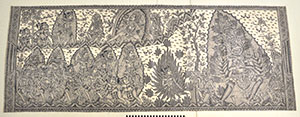Cloth Painting: "Burning of the Love God," scene from Semaradahana, Twelth-Century Javanese Poem
2002.17.0022
Detailed Images
Basic Information
| Artifact Identification | Cloth Painting: "Burning of the Love God," scene from Semaradahana, Twelth-Century Javanese Poem (2002.17.0022) |
|---|---|
| Classification/ Nomenclature |
|
| Artist/Maker | Unknown |
| Geographic Location | |
| Period | N/A |
| Date | 20th century |
| Culture | Balinese Hindu, Indonesian |
| Location | Not on Exhibit |
Physical Analysis
| Dimension 1 (Width) | 208.2 cm |
|---|---|
| Dimension 2 (Depth) | 80.3 cm |
| Dimension 3 (Depth) | <0.1 cm |
| Weight | 349 g |
| Measuring Remarks | Under Review |
| Materials | Textile, Pigment |
| Manufacturing Processes | Painting |
Research Remarks
| Description | In the painting from which this detail comes, Asmara, the god of love, shoots arrows at the god Siwa to arouse his lust. Enraged by having his meditation disturbed, Siwa, as a giant, many-headed demon (pamurtian), shoots fire from his third eye, surrounding Asmara in flames. Later in the story, Asmara’s wife Ratih, the goddess of love, immolates herself; together, they are consumed by the fire. |
|---|---|
| Published Description | N/A |
| Bibliography | Under Review |
Artifact History
| Credit Line/Dedication | Gift of Professor John Garvey. |
|---|---|
| Reproduction | N/A |
Contact
All information about our collection is constantly reviewed and updated. Please contact Dery Martínez-Bonilla, Registrar, if there is any information you are looking for that isn't currently online.
